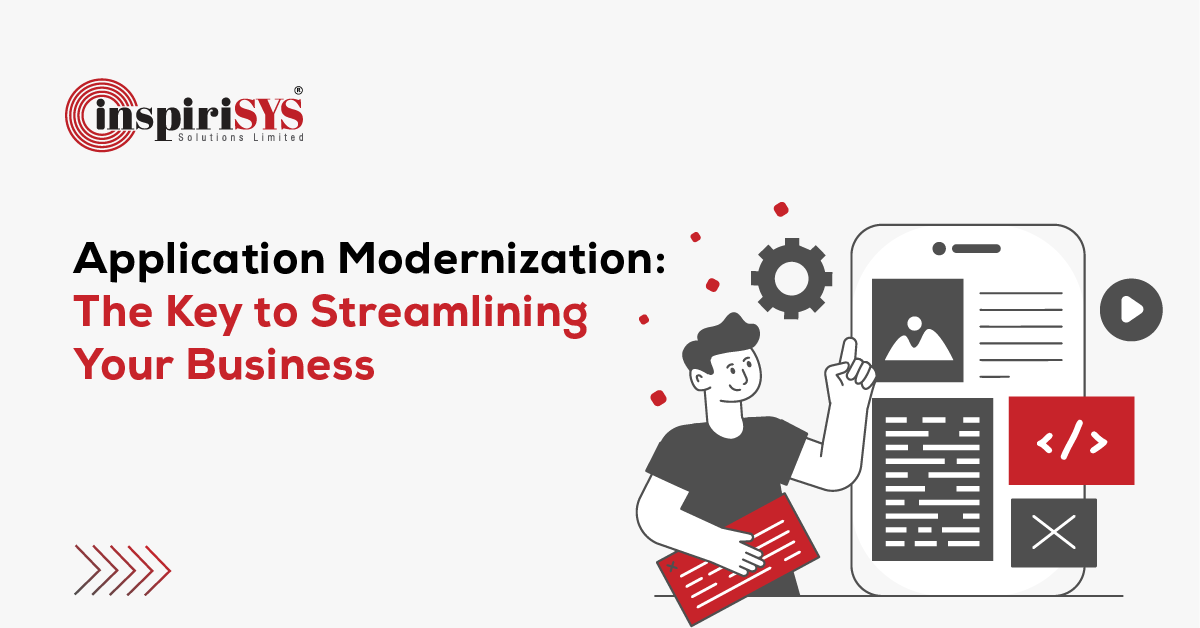Quick Summary: Application Modernization is the process of updating the existing applications to the cloud. This blog covers an overview of Application Modernization, Tools, Benefits, Challenges and Approaches. Learn how Application Modernization plays an important role in the digital era.
Over recent years, the IT field has witnessed an unprecedented transformation. Despite working in a new digital environment, many IT organizations face difficulties because they continue to depend on monolithic legacy systems. Additionally, they also failed to anticipate the creation of composite applications.
Business executives are now focusing on creating a roadmap for application modernization to enhance the IT infrastructure.
According to the survey conducted by Valuates, the global application modernization service market is expected to reach USD 50440 by 2028, at a CAGR of 15.1% between 2023 and 2028.
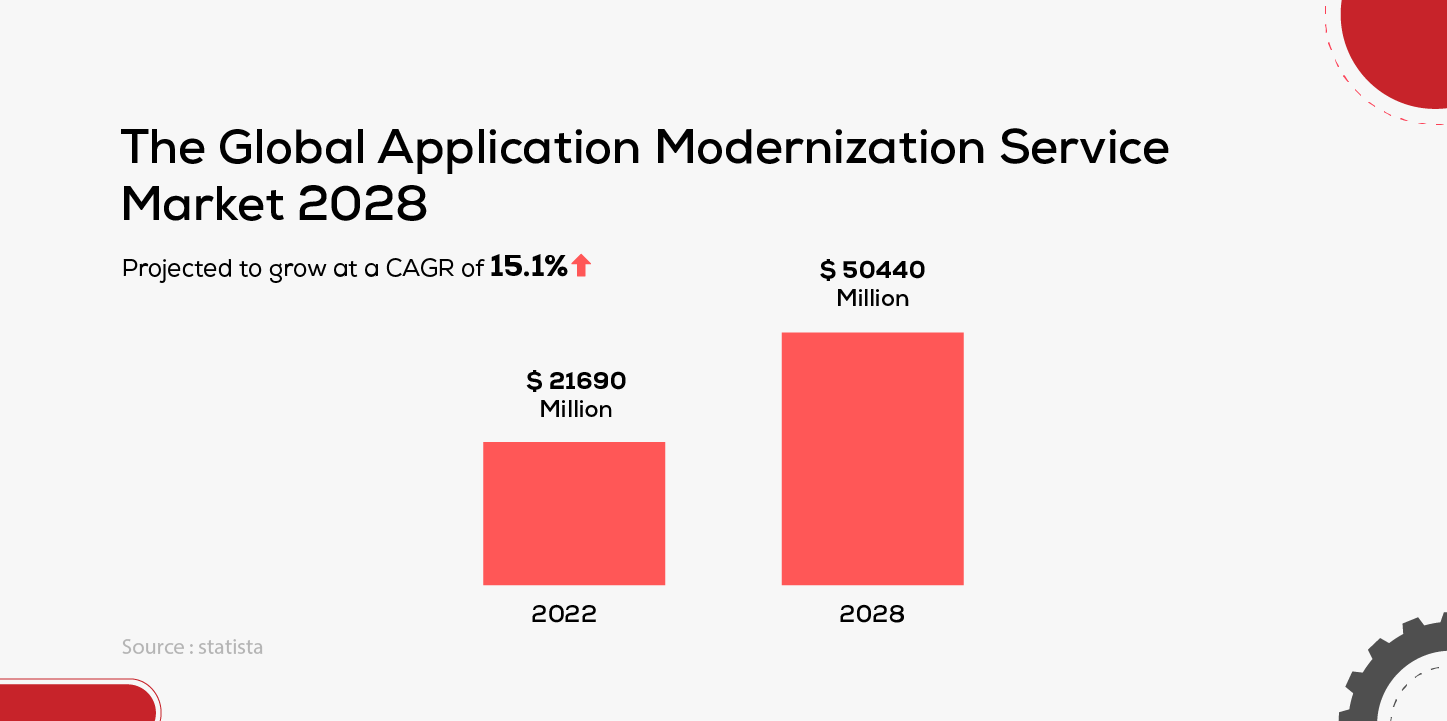
What is Application Modernization?
In simple terms, application modernization is to redesign the organization’s present apps to a cloud so that they can run effectively. This is also known as legacy modernization. This process includes migrating the apps to a private, public or hybrid cloud.
In recent times, the conversation about cloud application modernization has revolved around on-premises applications and monolithic applications. In this process, the older applications are updated to use more recent computing paradigms like frameworks and application architectures.
What is the Need for Modernization?
Modernizing legacy applications doesn't just involve replacing them; it enhances security and efficiency.
The primary goals of app modernization are:
-
Transforming monolithic and on-premises systems into cloud-native designs
-
Implementing an updated release pattern
-
Enhancing the organization's brand reputation
-
Reducing operational costs
Essential Application Modernization Tools
Organizations looking to modernize their apps need to consider these tools. Some of the tools are as follows:
1. Containers:
The applications are ‘abstracted’ from the environment in which they run using a technology called a container. It provides the flexibility to move from one platform to another. Here, the developers will be able to produce reliable apps that can run in several settings. Some of the added benefits of containers are portability, operational efficiency, and scalability.
2. Cloud Native Computing:
This model uses the cloud to conduct off-site operations. Further, this technology outsources the code to the cloud provider. The code is executed when requests come in.
3. Monolithic to Application Modernization Microservices:
The shift from monolithic to application modernization microservices is more effective. Using microservices is more feasible, and updates are accessible.
Exploring the Benefits of App Modernization for Business
Modernizing the application helps us stay flexible and competitive. Apart from this, it also includes additional benefits that are even more important. The list is as follows:
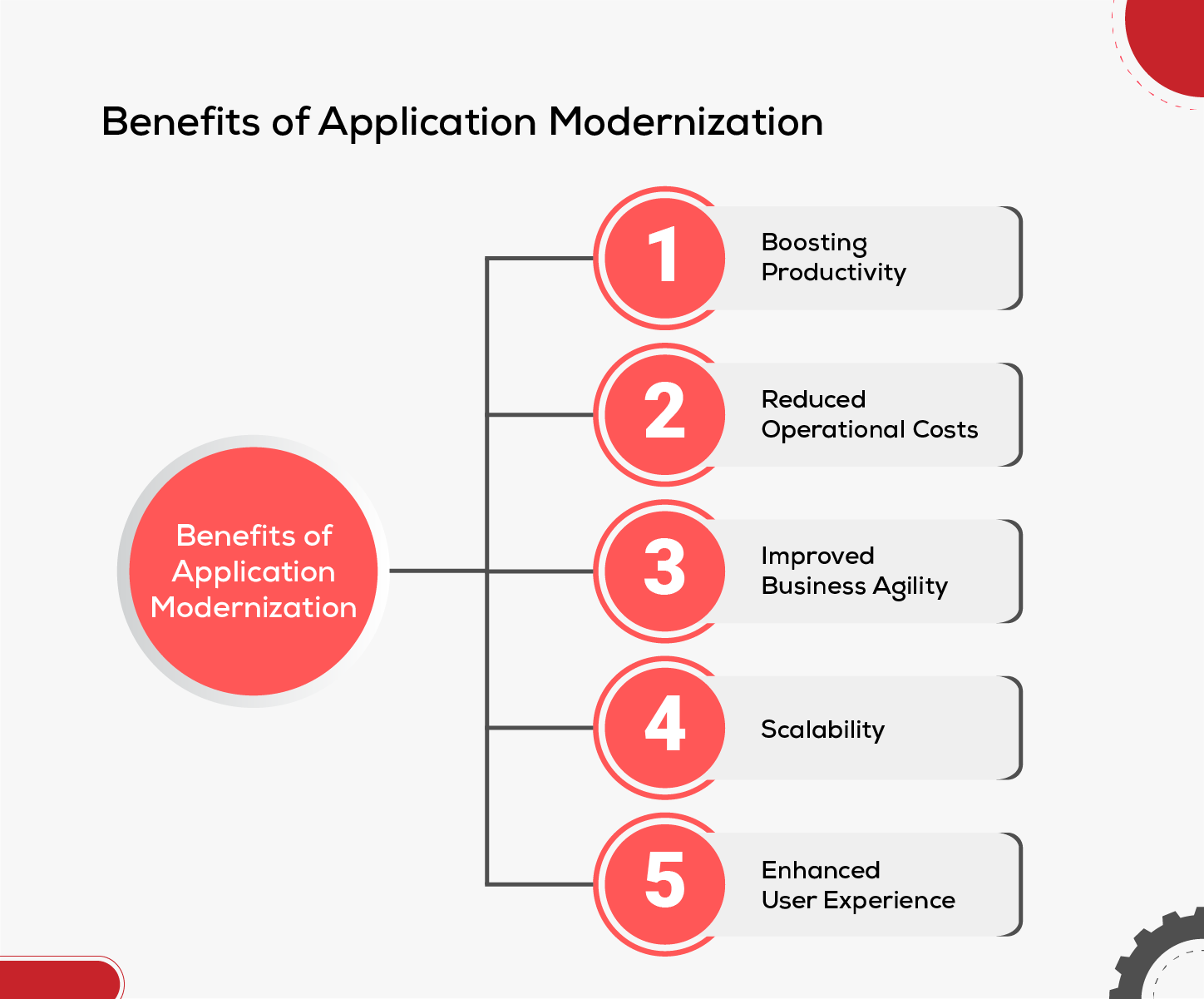
-
Boosting Productivity
Teams working on administration and development are more effective when they have access to cutting-edge tools and modern technologies. Additionally, it becomes easier to train new employees, automate boring tasks, reduce monotony in work, and significantly boost employee productivity. Moreover, it allows the employees to work simultaneously on various tasks, thereby increasing time to market.
-
Reduced Operational Costs
Maintaining an application can be challenging. Generally, a lot of money is invested to maintain the applications. Some of the additional expenses of a business include IT maintenance, capital expenditures, and on-site data centers.
Whereas application modernization helps the business reduce the cost spent on updates. As part of app modernization, monolithic apps must move to a cloud infrastructure, eliminating the need for local data centers. Thus, everything needs to be maintained and stored on the cloud. Therefore, licensing costs are decreased.
-
Improved Business Agility
With legacy systems and monolithic applications, organizations tend to lose agility and productivity. As a result of a lack of productivity and agility, businesses tend to lose customers. Further, with constant system updates, agility can be anticipated. Better performance is witnessed when the application is more reliable and consistent
-
Scalability
Since the technology is emerging rapidly, the need for upgrades is also high. Hence, businesses must adapt to boost revenue and face competitors. This can be challenging with legacy systems. They need storage solutions to meet the changing requirements.
However, with the availability of the cloud’s scalability, businesses can increase or decrease their IT resources to handle heavier or lighter loads.
-
Enhanced User Experience
The success of every business depends on the positive impact of user satisfaction. Delivering a good customer experience while maintaining an outdated legacy system is difficult. Moving the applications to the cloud infrastructure can reduce the burden. By doing so, customers find it easy to navigate modern applications.
Key Challenges to Application Modernization
Though app modernization offers numerous benefits, it also causes several challenges. These challenges include:
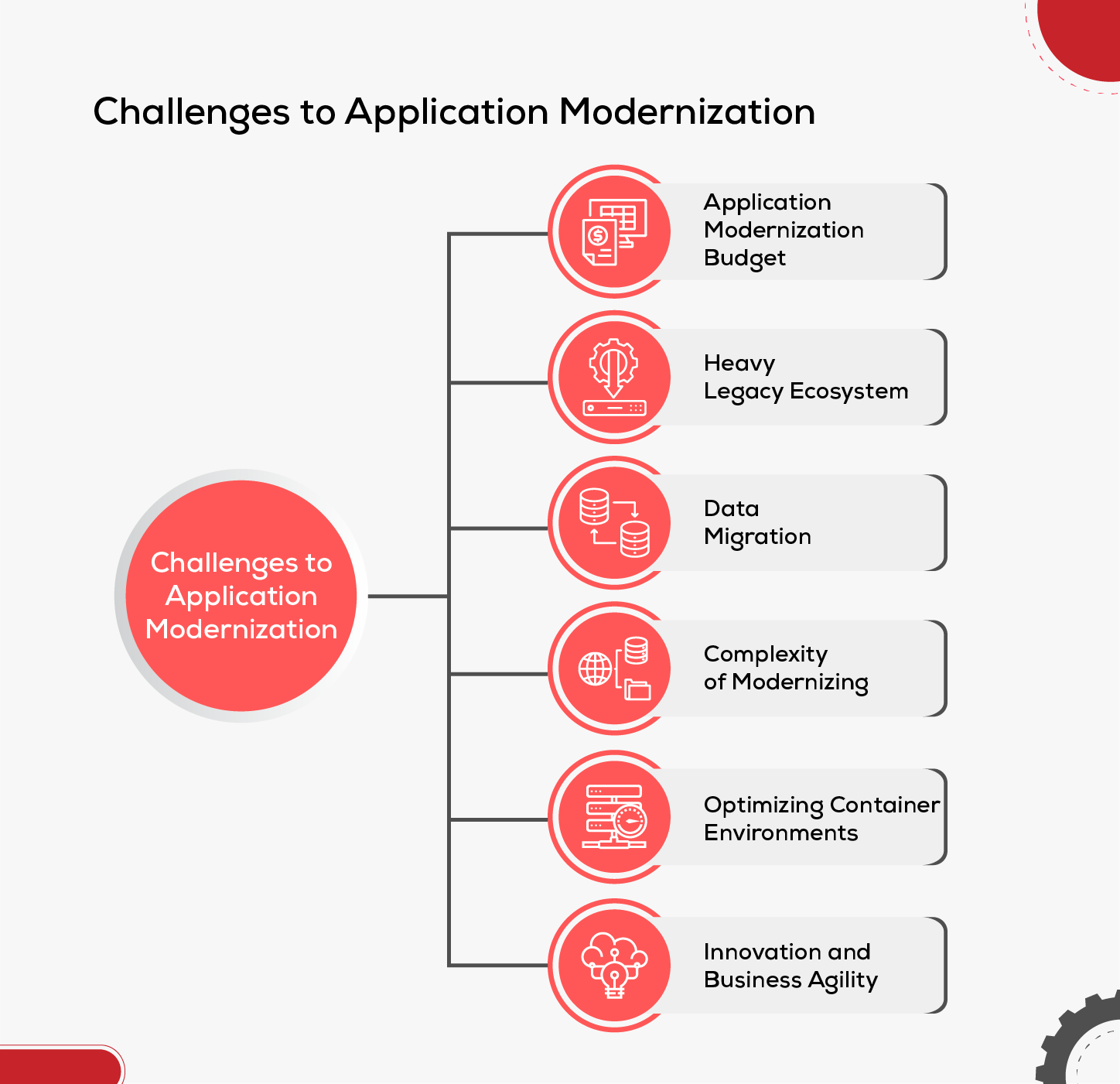
-
Application Modernization Budget
The main barrier preventing many organizations from adapting their apps to the demands of the modern world is cost. It is difficult to determine the accurate budget for maintaining legacy apps. The infrastructure and cloud platform prices are high.
Thus, to keep the whole process reasonable, one must divide the monolithic legacy application into parts.
-
Heavy Legacy Ecosystem
The significant impact on business lies in the entire legacy ecosystem. Further, with various file formats, the upstream and downstream would still be in legacy applications.
In such circumstances, applications must be modernized first before moving on to the next. In addition, some tools can be used to support legacy practices that don’t disturb the business flow.
-
Data Migration
Maintaining data integrity and preventing data loss are crucial during the process. There is a significant amount of business data in the form of gigabytes, terabytes, or petabytes. There are a few tools in the market to deal with code variations. Also, some ELT plugins make data migration easier. Moreover, VSAM files can be migrated to NoSQL databases.
-
Complexity of Modernizing
Organizations face problems with the rapidly rising volume of applications, the siloed infrastructure that supports each application and the diversity of application styles and internal architecture. Further, the complexity of multi-cloud operations is another challenge.
-
Optimizing and Rightsizing Container Environments
Utilizing containers like Kubernetes enables the software development team to increase agility, operational effectiveness, and speed. But occasionally, companies under-allocate these containers, which results in out-of-memory errors and service assurance issues. On the other hand, this over-allocation results in overspending.
Thus, identifying the right Kubernetes containers, both without resource limits and with tight limits, is crucial for resolving the problem. Finally, the overcommit of clusters can be identified and adjusted.
-
Vendor Lock-in can Stifle Innovation and Business Agility
Generally, vendor lock-in involves a situation where the customer is required to stick with the original vendor because switching would be expensive. Due to financial limitations, a labour shortage, or to avoid disruption in business operations, the customer is locked. Thus, moving to another vendor can be demanding. This might result in technical incompatibilities and higher costs.
Here are some of the right ways to deal with vendor lock-in:-
To research potential cloud vendors
-
Ensure data portability, clearly state the data model and utilize plan standards
-
Make software portable
Therefore, with a proper understanding of the industry's needs, and by choosing the right tools, these challenges can be addressed.
-
Application Modernization Approaches: A Comprehensive Overview
An effective modernization strategy can decrease the number of resources needed to run an application, enhance uptime resilience and increase the dependability of deployments. But, before making a choice, you should think about the commonly used options for modernizing the application.
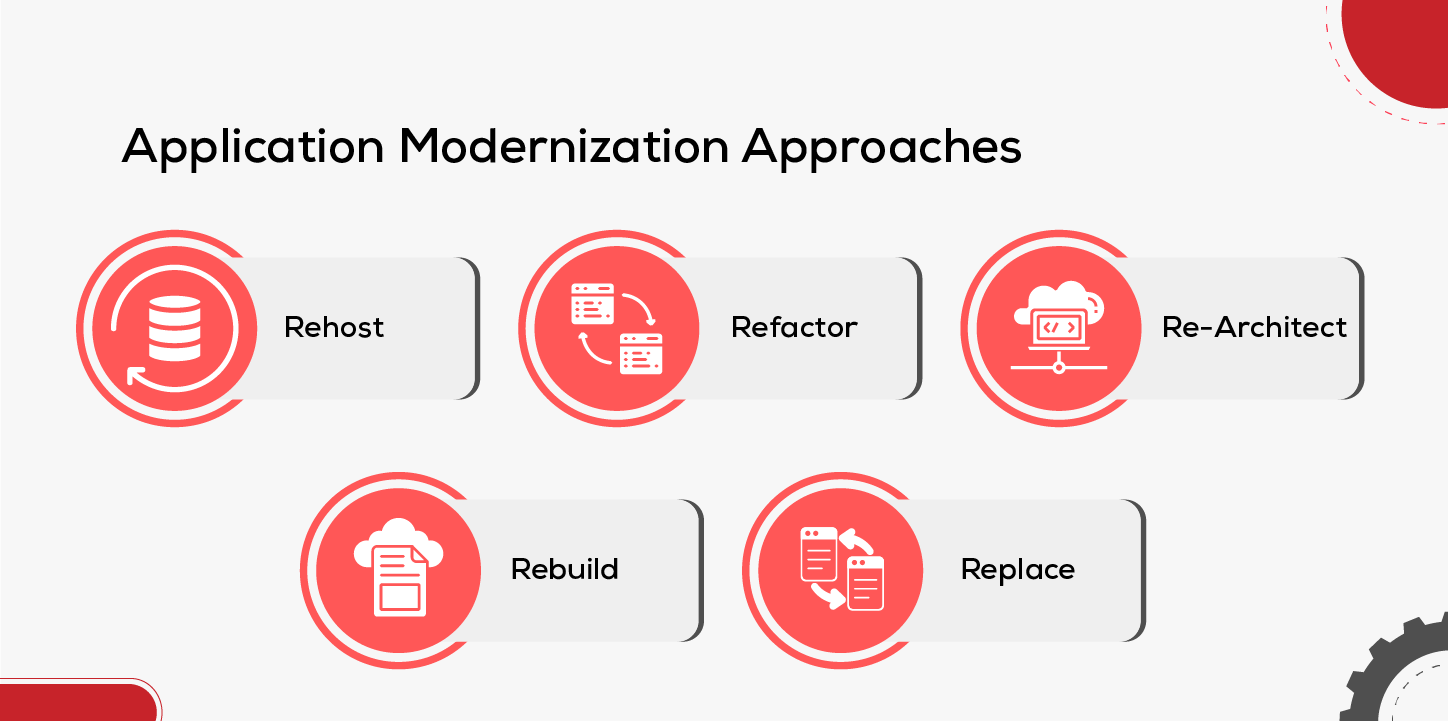
-
Rehost
Re-hosting is a popular technique for moving applications from a legacy environment to the cloud. This method is also known as “Lift and Shift”. Further, this method is considered the faster migration method and adds benefits for organizations that need to vacate an on-premises data center. Additionally, business methods and practices remain the same as architectures aren’t changing.
Pros:
-
Easier to scale
-
Minimal downtime
Cons:
-
Increased costs
-
Not optimized for cloud
-
-
Refactor
Through the process of refactoring, code can be recognized while keeping its outward behaviour. With refactoring, simplifying code and lowering the sum of technical debt is an added advantage. Further, the refactoring technique can be used to optimize applications and update them.The process can become complex when source code changes are made and modern technologies are introduced.
Pros:
-
Low cost
-
Reduce technical debt
-
Low risk
Cons:
-
Lengthy project timeline
-
Advanced cloud knowledge
-
Retain outdated architecture
-
-
Re-Architect
This process involves redesigning an application and giving it a modular architecture. To get greater scalability and reliability, this process modifies the existing codebase for a cloud platform. Since the process requires an app code change, the migrating process can be time-consuming. However, it only requires material changes or decomposing the application rather than complete rebuilding.
Pros:
-
Business agility
-
Speed to market
-
Reduced costs
Cons:
-
Time-consuming
-
Higher amount of initial efforts
-
-
Rebuild
As the name suggests, the current application is entirely rebuilt using cloud PaaS (Platform as a Service) or even SaaS (Software as a Service) services and architecture. Rebuilding includes eliminating the current code and restructuring the application present in the cloud. When rebuilding, the original scope and specifications are maintained while meeting new technological requirements.
Pros:
-
Build applications faster
-
Reduce operational costs
-
Release value faster
Cons:
-
Time-consuming
-
Security issues like new bugs
-
-
Replace
This migration strategy makes use of Saas to entirely replace an existing application. Replace helps us to identify the root cause of the problem and find the right solution. This strategy ensures the app’s security features and accessibility, by having a service provider that manages all underlying infrastructure, app software and app data.
Pros:
-
Relatively simpler and faster option
-
Potential cost saving
-
Better security
Cons:
-
Higher risk of errors in the code
-
Time-consuming
-
How Can you Ensure the Success of Modernizing your Application?
The success of app modernization can be ensured by following the below steps:
- Address technical debt
- Choose the right modernization approach
- Complete analysis
- Strengthen the test automation
- Hiring the right team
To Sum Up
The need to modernize software and applications is growing due to the rapdi development in all technological fields. The process of modernizing applications can differ and is constantly changing depending on the infrastructure, systems and market changes.
Application Modernization is a difficult but crucial step that will help you develop your business. Given all the benefits that application modernization offers, you should update your monolithic application as soon as you can. It is the right choice to update current business-critical applications. However, switching to a cloud-native architecture can make the difference between a successful migration and an unmanageable backlog.
Frequently Asked Questions
1. What should the application modernization strategy include?
While addressing application modernization strategy, organizations should focus on and include Containers and Kubernetes, Microservices, Cloud, Increased Security, DevOps and seamless data sharing between various systems and applications.
2. What are some of the common examples of application modernization?
The examples of application modernization commenced by adopting the use of microservices to help teams deploy more quickly and scale at a lower cost. Further, it improves automation through streamlined toolchains, improving visibility and boosting agility.
3. What is the role of DevOps in Application Modernization?
The DevOps methodology is frequently used by businesses to upgrade their applications. Further, DevOps plays a major role and includes Increased collaboration between different teams, Faster time to market, Greater stability and Increased reliability.
4. What are the best practices to reduce the risks and costs of application modernization?
Some of the best practices to reduce the risks and costs of application modernization include Strategize the transition, To select the most suitable modernization approach, Establish the design needs and Identify outdated or malfunctioning components.
5. What are the business risks involved in modernization, and how to lower the risks?
While moving away from legacy apps, businesses should be cautious of potential quality losses and cost factors. There are risks involved, such as not having the necessary skills to use modern platforms or encountering issues or newer platforms. However, following are some recommendations to reduce the migration risks: The migration process could be time-consuming. Therefore, it is necessary to consider the overall cost of the transition in advance. An end product can be developed based on user experience using DevOps or Agile methodologies. Automating the development and testing can speed up transitions and lowers the risks of errors.


